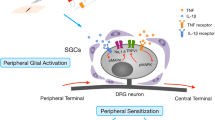Abstract
Injection of formalin into a hind paw of rats produces localized inflammation and pain. The nociceptive effect of formalin, recorded as flinching/shaking of the injected paw, is biphasic. The present study shows that formalin-induced inflammation and edema (assessed by measurement of paw volume up to 24 h post-injection) is also biphasic, an early neurogenic component being followed by a later tissue-mediated response. Rapid initiation of edema is closely related to early phase nociception and is dependent on activity in primary afferent neurons and axon reflexes, but not on transmission of the noxious stimulus and the perception of pain itself. The major site responsible for down-regulating the inflammatory response, particularly in the later stages when tissue-mediated components are most heavily involved, appears to be located supraspinally. Down-regulation occurs principally by means of descending neuronal pathways but may also involve a secondary humoral component. The perhaps surprising dependence on neuronal mechanisms which this study demonstrates promotes spinal and peripheral sites as potential therapeutic targets in certain inflammatory conditions.
Similar content being viewed by others
References
F. V. Abbott, R. W. Grimes and R. Melzack,Single nerve capsaicin: effects on pain and morphine analgesia in the formalin and foot flick tests. Brain Res.295, 77–84 (1984).
T. L. Yaksh, D. H. Farb, S. E. Leeman and T. M. Jessell,Intrathecal capsaicin depletes substance P in the rat spinal cord and produces prolonged thermal analgesia. Science206, 481–483 (1979).
H. Wheeler-Aceto, F. Porreca and A. Cowan,The rat paw formalin test: comparison of noxious agents. Pain40, 229–238 (1990).
D. Dubuisson and S. G. Dennis,The formalin test: a quantitative study of the analgesic effects of morphine, meperidine and brain stem stimulation in rats and cats. Pain4, 161–174 (1977).
N. Janscó, A. Janscó-Gábor and J. Szolcsányi,Direct evidence for neurogenic inflammation and its prevention by denervation and by pretreatment with capsaicin. Brit. J. Pharmacol. Chemother.31, 138–151 (1967).
C. A. Maggi and A. Meli,The sensory-efferent function of capsaicin-sensitive sensory neurons. Gen. Pharmacol.19, 1–43 (1988).
Author information
Authors and Affiliations
Rights and permissions
About this article
Cite this article
Wheeler-Aceto, H., Cowan, A. Neurogenic and tissue-mediated components of formalin-induced edema: Evidence for supraspinal regulation. Agents and Actions 34, 264–269 (1991). https://doi.org/10.1007/BF01993299
Issue Date:
DOI: https://doi.org/10.1007/BF01993299




